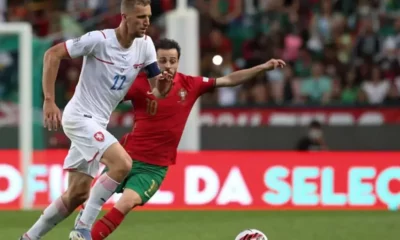Football
Czech national team at Euro 2020: general analysis
The Czech national team achieved great success at the Euro. The quarter-finals are a result-over-plan and the current ceiling. Performance-wise, however, it wasn’t such a glory. Using data and tactical analysis, we analyzed the performance of the Czech team.
The Czech national team achieved great success at the Euro. The quarter-finals are a result-over-plan and the current ceiling. Performance-wise, however, it wasn’t such a glory. Using data and tactical analysis, we analyzed the performance of the Czech team. What was the Czech team’s approach to the matches, what did the Czechs do to make the game uncomfortable for their more famous opponents and what didn’t work out at all?
IN GENERAL ABOUT THE CZECH TEAM
The Czech team relied heavily on their physical disposition, chemistry and limiting simple mistakes defensively in qualifying.
REPLAY
That’s why the stoppers sent long balls behind the defence during the set pieces, where the winger, central offensive midfielder or possibly a spike striker would run in. Such sending of long balls is uncontrolled and random, the opponents’ trackers usually picked them up, but then there was Czech counter-pressing, in which Czech players used their physical dispositions.
It has to be said that such a strategy is very far from the modern concept of football, but at the same time it worked out and was quite effective. Due to the constructiveness of the stoppers and Vaclik, it would have been impossible to play under pressure and with long balls the Czechs at least managed to create pressure on the opponent. Jaroslav Šilhavy’s charges were also very successful in collecting deflected balls.
In the first visualisation from the left you can see all the passes from the defensive third – the Czech players played long balls to the edge of the field behind the opponent’s defence, which is beautifully highlighted in the second and third pitches.
The strategy of long balls to the edge can be seen in the passes of the stoppers and goalkeeper Vaclik.
STRATEGY AGAINST THE OPPONENT’S MIDDLE/LOW BLOCK
If the opponent was pushed at least into the middle block, the Czechs tried to constantly rotate in the outer spaces. The rotation was really constant, with players changing positions, keeping relatively small distances between each other and trying to get to the centre from the side. The Czech national team played almost exclusively through the right side, where Coufal was tireless and excellent going forward. The left back Bořil stayed more at the back and was rarely involved in forward combinations.
This approach to ball possession was full of advantages, but also disadvantages. The fact that the Czechs were constantly rotating made it very difficult for the opponents to pick up the constant rotations, which is why it sometimes happened that one of the Czech players came free. This was especially true when the opponent was defending personally. When the team around the captain Darida played almost only through the edges, they avoided any losses in the middle of the field, after which the opponent would have had it closer to Vaclik’s goal than when he got the ball on the edge.
At the same time, the centre of the pitch is usually much more compacted than the edges, where there is more space. However, it is clear that spaces on the edges of the pitch are far less dangerous and attacks through the middle are statistically more successful. By playing only through the edges, the Czechs were depriving themselves of a lot of options.
The players had a “free hand” when rotating and were not too bound by the tactical instructions of coach Jaroslav Šilhavy. This was unpredictable for the opponents and, as I have already mentioned, led to occasional unrecruited players. On the other hand, it was also an extremely cognitively demanding strategy for the Czech players. Every situation was new for them. A player of the Czech national team always had to look and scan the whole field to know what his options were.
Whereas when Verratti or Pedri, for example, took the ball, the midfielders of Italy and Spain (the teams with the best structure and tactical preparedness in the whole EURU) knew exactly what their options were.
Modern football is about control. Teams occupy space in order to get into certain spaces consistently according to given principles and rehearsed movements. At top club level, almost every team knows exactly what structure they want to create in each phase of the game and what they want to achieve in that phase of the game.
In the Czech national team, the structure is left up to the players and their intuition at any given moment. This leaves the coach out of control in the forward direction and leaves it to “chance”. That is why the Czech national team did not create chances in a controlled way. At the same time, very often the players changed positions so that it was impossible to get into any interesting space.
On the other hand:: even though every situation was new for the Czech players and they had to constantly scan their options, they were pretty well together. Coach Šilhavy didn’t shuffle the line-up too much and the players were used to each other.
Coufal’s importance and overall reliance on the right side can be seen beautifully on the expected danger (xThreat).
This can also be seen in the visualization, which shows where the Czechs were moving the ball from and to.
Which players were more unsuccessful in moving the ball according to the xT (expected danger) metric?
The passing territories show a lot of rotation in the Czech game, which is reflected in a rather chaotic arrangement of players around the field.
On the last pitch on the bottom right, you can see that the Czechs hardly play through the middle of the pitch and use exclusively the outermost spaces to attack.
The spike striker Schick often ran to the edges of the pitch, especially for long balls.
FINAL THIRD – CENTRES
Both the build-up and the final period saw a lot of variance, as the Czechs relied on centres in the final third to fill the whitewash in high numbers. However, you never know with centers how they will turn out. Fifteen times it doesn’t work out, then once it does and it’s a goal, then 20 times you center “to no avail”. Chance decides… Centres are also not effective as a primary strategy to create chances.
In the following visualisation, you can see that the Czechs were entering the whitewash exclusively from the edges of the pitch, using Coufal the most.
DEFENSE
The Czech national team was very aggressive in their pressing in qualifying, manning their opponents personally so that each player had his own player. This worked well with the high pressing – the stoppers had to undergo tough 1v1 battles against the opponent’s forwards, but the midfielders were very good at collecting deflected balls, so the opponent could not control the game.
But in the regular group the Czech national team stopped pressing so high and moved to the middle block, which didn’t work at all. The Czechs kept manning the opponent but often left one stopper free. This provided more “security” at the back, but Šilhavy’s charges were unable to create pressure on the opponent’s first phase of play. The opponent always had at least one player free in the first phase of the game, which they were able to take advantage of. The Czechs sometimes failed to switch to full personal defense when it was outright offered to have both stoppers have players, but preferred to stay with only one striker.
The opponent was thus offered control and, thanks to the advantage of one player on the ball, he was able to push the Czech national team. Personal defence in the middle block is a purely reactionary strategy. The Czech players just followed the opponent’s players, which the opponent was able to take advantage of with manipulations. In particular, England was able to open up different spaces or disengage from the personal defence by using different rotations, after which the Czech players had trouble occupying the opponent’s players.
The visualization shows where the Czech national team’s defensive actions took place. At first glance, you can clearly see the medium or low block that coaches Jaroslav Šilhavy and Jiří Chytrý resorted to in the group matches.
The national team returned to high pressing against the Netherlands and Denmark, which worked much better. Even though it is at first glance a “riskier” strategy, the Czech national team had problems against these two opponents only when they were pushed into the middle block.
More on the xT metric here.
Sources:
TACTICAL ANALYSIS – JAKUB LEBLOCH(@JakubLebloch)
DATA ANALYSIS – DAVID ROZLIVEK(@rozlivek99)












